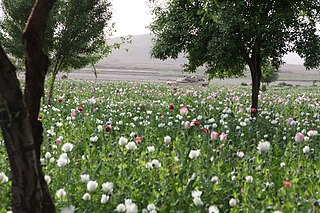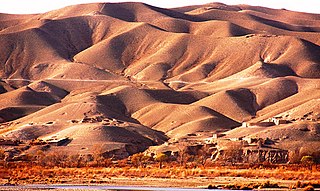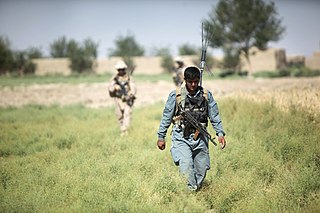Related Research Articles

Ahmed Wali Karzai was an Afghan politician who served as Chairman of the Kandahar Provincial Council from 2005 until his death. He was the younger paternal half-brother of former Afghan President Hamid Karzai and an elder of the Popalzai tribe. Wali Karzai formerly lived in the United States,where he managed a restaurant owned by his family. He returned to Afghanistan following the removal of the Taliban government in late 2001. He has been accused of political corruption and was allegedly on the CIA payroll. He was assassinated by one of his close bodyguards,Sardar Mohammad,on 12 July 2011.

Helmand,also known as Hillmand,in ancient times,as Hermand and Hethumand,is one of the 34 provinces of Afghanistan,in the south of the country. It is the largest province by area,covering 58,584 square kilometres (20,000 sq mi) area. The province contains 18 districts,encompassing over 1,000 villages,and roughly 1,446,230 settled people. Lashkargah serves as the provincial capital. Helmand was part of the Greater Kandahar region until made into a separate province by the Afghan government in the 20th century.

Lashkargāh,historically called Bost or Boost,is a city in southwestern Afghanistan and the capital of Helmand Province. It is located in Lashkargah District,where the Arghandab River merges into the Helmand River. The city has a population of 201,546 as of 2006. Lashkargah is linked by major roads with Kandahar to the east,Zaranj on the border with Iran to the west,and Farah and Herat to the north-west. It is mostly very arid and desolate. However,farming does exist around the Helmand and Arghandab rivers. Bost Airport is located on the east bank of the Helmand River,five miles north of the junction of the Helmand and Arghandab rivers. Because of the trading hubs,it is Afghanistan's second largest city in size,after Kabul and before Kandahar.

Grishk,also spelled Gereshk,is the new name of Zamindawar which is named after the invasion the region by Nader Afshar army and given to Ghilji tribe in 18th century. Grishk a town in Grishk District of Helmand province,geographically located along the Helmand River in Afghanistan,some 120 km (75 mi) northwest of Kandahar,at 817 metres (2,680 ft) altitude. Upstream lies the Kajaki Dam which diverts water to the Boghra Irrigation Canal,an essential infrastructure for the region's crops. Grishk Dam is also nearby. Grishk was originally built around a fort on the east bank of the river but was later rebuilt on the west. The fort was twice captured by the British:first in the First Anglo-Afghan War and again in 1879. In both cases the fort was later abandoned. Grishk has a population of about 48,546 and has a hospital and a school of engineering which was built back in 1957.

Afghanistan has long had a history of opium poppy cultivation and harvest. As of 2021,Afghanistan's harvest produces more than 90% of illicit heroin globally,and more than 95% of the European supply. More land is used for opium in Afghanistan than is used for coca cultivation in Latin America. The country has been the world's leading illicit drug producer since 2001. In 2007,93% of the non-pharmaceutical-grade opiates on the world market originated in Afghanistan. By 2019 Afghanistan still produced about 84% of the world market. This amounts to an export value of about US $4 billion,with a quarter being earned by opium farmers and the rest going to district officials,insurgents,warlords,and drug traffickers. In the seven years (1994–2000) prior to a Taliban opium ban,the Afghan farmers' share of gross income from opium was divided among 200,000 families.
Mohammad Daoud was the governor of Helmand in Afghanistan until he was removed from his post for his ties to the opium trade. Daoud was appointed in December 2005,and replaced in December 2006 after the insistence of the British ISAF troops. The U.S. used the warlords to help them hunt Al Qaeda and the Taliban and it is rumored this extended to ignoring their involvement in the production and sale of opium.
Operation Mountain Thrust was a joint NATO and Afghan-led military operation in the War in Afghanistan. It involved more than 3,300 British troops,2,300 U.S. troops,2,200 Canadian troops,along with approximately 3,500 Afghan soldiers,supported by extensive air power. Its primary objective was to quell the ongoing Taliban insurgency in the south of the country.

The Kajaki Dam is "an earth and rockfill embankment type dam" located on the Helmand River in the Kajaki District of Helmand Province in Afghanistan,about 161 km (100 mi) northwest of Kandahar. It has a hydroelectric power station,which is operated by the Helmand and Arghandab Valley Authority through the Ministry of Energy and Water.

Musa Qala is a district in the north of Helmand Province,Afghanistan. Its population was around 57,500 in 2012 and are 97% ethnic Pashtun. The district centre is the village of Musa Qala;there are 19 other large villages and 200 smaller settlements,mostly along the Musa Qala River. The area is irrigated by the Helmand and Arghandab Valley Authority.

Nāwa-I-Barakzāyi District is an administrative district in Helmand Province,Afghanistan located south of the provincial capital of Lashkar Gah along the Helmand River. It is bordered by the districts of Lashkar Gah,Nad Ali,Garmsir,and Rig,as well as the provinces of Nimruz and Kandahar. It falls within the area known as Pashtunistan,,an area comprising most of southeast Afghanistan and northwest Pakistan. The dominant language is Pashto and many of the 89,000 residents practice the traditional code of Pashtunwali. Nawa-I-Barakzayi's name reflects the dominant Pashtun tribe in the district,the Barakzai. Prior to the 1970s,it was called Shamalan after a small village at the south end of the district

Garmsir District is located in the southern part of Helmand Province,Afghanistan. The district is large,but all the villages are along the Helmand River. The rest is a desert. The district capital,Garmsir,is located in the northwestern part of the district on the east bank of Helmand River.

Amir Muhammad Akhundzada is an Afghan politician,He is a former governor of Nimruz province. He was previously the governor of Oruzgan province. Prior to that he served as Deputy Governor of Helmand province.

The siege of Sangin was a military engagement which occurred between June 2006 and April 2007,between Taliban insurgents and the British Army during the war in Afghanistan. During the engagement,the district centre of Sangin District in Helmand Province was occupied by British forces and was completely surrounded by Taliban fighters. At one point fighting became intensive,causing General David J. Richards,the then-NATO commander in Afghanistan,to declare that Helmand province had seen the fiercest fighting involving British troops since the Korean War. The siege became emblematic of the difficulty of the mission being carried out by British soldiers in Afghanistan,who nicknamed it "Sangingrad".

The Helmand province campaign was a series of military operations conducted by the International Security Assistance Force (ISAF) forces against Taliban insurgents and other local groups in the Helmand Province of Afghanistan. Their objective was to control a province that was known to be a Taliban stronghold,and a center of opium production. None of the ISAF's intended strategic and political objectives were achieved in the long term.
Mullah Abdul Salaam Alizai is a former member of the Taliban movement who defected to the Afghan government in December 2007. He is a leader of the Alizai,a Pashtun tribe.

The siege of Musa Qala took place between July 17 and September 12,2006 in Afghanistan's Helmand province. A small force of International Security Assistance Force (ISAF) troops and Afghan security forces were besieged by Taliban insurgents inside the district centre of Musa Qala.
Mullah Mohammad Nasim Akhundzada was a mujahideen commander and Pashtun warlord who operated in Helmand Province,Afghanistan during the 1980s. Based out of Musa Qala in northern Helmand,Nasim was from the Alizai tribe. He issued a fatwa legalizing poppy cultivation in 1981. During the 1980s he gradually consolidated power over most of Helmand,eliminating other mujahideen factions. He was assassinated in March 1990 in Pakistan. His nephew Sher Mohammad Akhundzada was the governor of Helmand until 2005 and is an important Afghan politician.
This article summarizes the history of the War in Afghanistan (2001–2021).
The politics of Afghanistan are based on a totalitarian emirate within the Islamic theocracy in which the Taliban Movement holds a monopoly on power. Dissent is not permitted,and politics are mostly limited to internal Taliban policy debates and power struggles. As the government is provisional,there is no constitution or other basis for the rule of law. The structure is autocratic,with all power concentrated in the hands of the supreme leader and his clerical advisors. According to the V-Dem Democracy indices Afghanistan was as of 2023 the 4th least electoral democratic country in the world.
The 2006 Taliban offensive was a major military offensive launched by the Taliban in southern Afghanistan in the spring of 2006. The offensive was planned to unfold on three main fronts concentrated in the provinces of Helmand and Kandahar:the first front was to target northern Helmand,focusing on the districts of Sangin,Nowzad,and Kajaki. The second front aimed at southern Helmand,with a focus on the districts of Garmser and Nawa. The third,and most important,would be western Kandahar,targeting the districts of Maiwand,Zharey,and Panjwayi.
References
- ↑ Malkasian, Carter (2013). War Comes to Garmser: Thirty Years of Conflict on the Afghan Frontier. Oxford University Press. p. 21. ISBN 978-0-19-997375-0.
- ↑ (2006) Antionio Giustozzi, Crisis States Research Centre, LSE and Noor Ullah. "'Tribes' and Warlords in Southern Afghanistan, 1980-2005."
- ↑ Malkasian 2013, p. 49
- ↑ Malkasian 2013, p. 55.
- ↑ Malkasian 2013, p. 83.
- ↑ Malkasian, Carter (2021). The American War in Afghanistan: A History. Oxford University Press. pp. 125–126, 129. ISBN 978-0-19-755077-9.
- ↑ Bergen, Peter. "Helmand: bombs, drugs, and the Taliban". Foreign Policy. Retrieved 7 November 2022.
- ↑ Suhrke, Astri (2011). When More is Less: The International Project in Afghanistan. London: C. Hurst. p. 107. ISBN 978-1-84904-164-5.
- ↑ Farrell, Theo (7 September 2017). Unwinnable: Britain’s War in Afghanistan. Random House. p. 167. ISBN 978-1-4735-2240-4.
- ↑ Farrell, Theo (7 September 2017). Unwinnable: Britain’s War in Afghanistan. Random House. p. 167. ISBN 978-1-4735-2240-4.
- ↑ Malkasian, Carter (2021). The American War in Afghanistan: A History. Oxford University Press. p. 132. ISBN 978-0-19-755077-9.
- ↑ Simpson, Emile (1 May 2018). War From the Ground Up: Twenty-First Century Combat as Politics. Oxford University Press. p. 44. ISBN 978-0-19-093484-2.
- ↑ Ilyas Dayee, Mohammad; MacKenzie, Jean; Gardesh, Hafizullah. "Helmand Ex-Governor Joins Karzai Blame Game". Institute for War & Peace Reporting. Retrieved 27 April 2015.
- ↑ President Karzai’s supporters ‘buy’ votes for Afghanistan election, The Times , 2009-08-12
- ↑ "President Karzai’s supporters ‘buy’ votes for Afghanistan election"